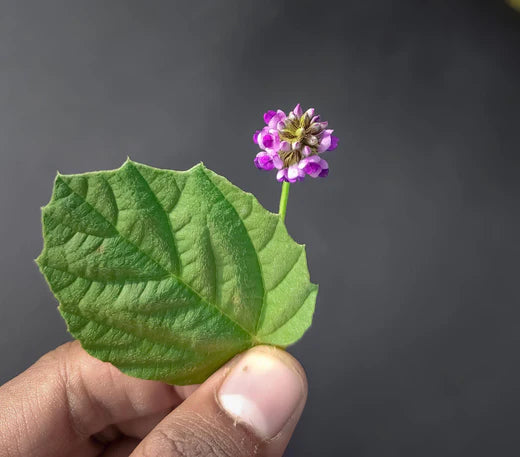Small, erect, annual plant that can reach a height of 60 to 120 cm. The elongated, flat, and brownish-black seeds of this plant. The kidney-shaped seeds have a strong bitter flavor and odor. Simple, spherical, and mucronate leaves are present at the apex of this plant. The plant's flowers are bluish-purple and yellow in hue. Fruits have a modest, slightly compressed size of 5mm.
General information
The Indian medical system has long used the significant herb Bakuchi, and it continues to offer people today a variety of herbal treatments. This plant's natural properties include being chemoprotective, anti-inflammatory, anti-oxidant, and anti-microbial. Every component of this plant is valuable due to its therapeutic qualities, however, the seeds are particularly successful at treating a variety of illnesses. This plant's seeds have a variety of medicinal properties, including those that are diuretic, aphrodisiac, astringent, cardiac, cytotoxic, and anti-inflammatory. The name Kusthghan means "destroyer of leprosy." It is used to treat a number of conditions including leucoderma, rashes, and skin-related illnesses. The plant also has the ability to purify the blood. Various dental conditions are treated with roots. Fruits' antimicrobial properties are employed to eliminate pathogen-causing microorganisms.
This herb includes a number of chemical compounds, including corylin, isopsoralen, psoralen, bavachalcone, dehydriopsoralidin, and methyl 4-hydroxybenzoate.
Habitat
In the tropical and subtropical regions of the world, bakuchi is commonly cultivated. It is indigenous to South Africa and China. This shrub is readily available in the plains of India. Particularly, it can be found in India's semi-arid states of Rajasthan, the eastern portion of Punjab, and Uttar Pradesh. It can be found all across the Himalayan areas.
Classification
- Kingdom - Plantae
- Order - Rosales
- Family – Fabaceae
Names
- Hindi name – Bakuchi
- Sanskrit name – Bvalguja, Bakuchi, Sitavari, Somraji, Krishnaphala, Chanderlekha, Chanderprabha, Kusthahantri
- Latin name - Posralea Corylifolia
- Punjabi name – Babchi
- Gujarati name – Babacha, Babichi
- Urdu name – Babechi
- Assam name – Habucha
- Kannada name – Bavanchi, Bavachige
- Bengali name – Habchu
- Tamil name – Karpokarishi, Karpokarlisi
- Telugu name – Bavanchalu
- Malayalam name – Karkokil, Kaurkolari
- German name – Bawchan
- Bangladesh name – Buckidana
- Arabic name – Loelab- el abid, Mahalep
- Sri Lankan name – Ravoli
- Chinese name – Ku-tzu, Cot-chu
Ayurvedic Properties
|
Particular |
Hindi / Sanskrit |
English |
|
Rasa (Taste) |
Tikta, Katu |
Bitter, Pungent |
|
Guna (Physical Property) |
Laghu, Ruksha |
Light, Dry |
|
Virya (Potency) |
Ushna |
Hot |
|
Vipaka (Post-Digestive Taste) |
Katu |
Pungent |
Effects on Doshas
It balances vata and kapha dosha.
|
Charak Samhita |
Sushrut Samhita |
Chakradutta |
Bhavprakash |
|
Tiktasaknda - bitter-tasting herbs |
Katu varga - Herbs with pungent taste |
Shwitr - herbs used in roga shwitr |
Haritkayadi - Herbs of haritaki group |
Varieties of Bakuchi
There are two varieties of bakuchi, as per chikitsa sathan in the Shushrut Samhita:
- Shweta bakuchi
- Krishna bakuchi
Practical Uses
- The whole plant is used in the medical system because of this herb's medicinal capabilities, which is one of its astounding facts. This herb's common name is kusthghan, and it is the greatest traditional treatment for leucoderma and kusthroga.
- This plant naturally purifies the blood. It is utilized to enhance immune support, give strength to the immune system, and cleanse the blood.
- Anti-inflammatory, anti-depressant, anti-cancer, and anti-hyperglycemic properties are present in it.
- This plant's seeds have diuretic and laxative properties and can be used to treat poisoning caused by scorpion and snake bites.
- Bronchitis, asthma, dyspnea, and other respiratory-related diseases can all be effectively treated with it.
- It is employed to treat worm infestations as well as dyspepsia.
- This plant's seeds are used to treat a number of skin conditions.
- This shrub's fruit, which has a bitter taste, is used to stop vomiting.
- The seeds of this plant are also used to decalcify teeth and bones.
- Fruits are used to cure a variety of bleeding disorders, including anemia and piles.
- It promotes hair growth and aids in the recovery of wounds and ulcers.
- It encourages skin rejuvenation and offers anti-aging benefits.
- It is applied to enhance the sheen and condition of hair.
- It is also a cardiac tonic and is used to treat a number of issues relating to the cardiovascular system.
- It enhances flavor and is used to treat anorexia.
- It calms the kapha and vata doshas, promoting ayurveda for kapha balance
Caution
This herb's oil is quite potent, and excessive use could result in skin discoloration.
Part Used
- Seeds
- Fruits
- Leaves
- Roots
- Flowers
Dosage
- Seed powder – 1-3gm
- Oil – 3-4 drops

